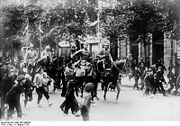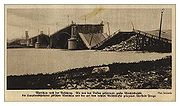.gif)
Great Retreat (Russian)
Encyclopedia
The Great Retreat was a Russian retreat from Galicia
and Poland
during World War I
.
. Four new German armies, the Eleventh, Twelfth, Army of the Niemen and Army Bug, were being formed up, dramatically shifting the balance of power in the area, with 13 Central armies facing nine Russian. Under pressure from the Kaiser, Falkenhayn gave in to Hindenburg and Ludendorff's insistence that the offensive be continued.
Stavka
decided to start a strategic retreat in order to gain time needed for the massive buildup of war industries at home.
's armies crossed the San River
and captured Przemyśl
. On 22 June, the Russians left the Galician capital of Lvov. Between June 23 and 27 the Germans crossed the Dniester
. In early July, Mackensen had to stop his offensive due to Russian counterattacks.
On 13 July, the Central Powers' armies opened a new offensive across the entire front. Outnumbered and still off-balance due to the earlier actions, the southern end of the Russian line collapsed and started moving northward, retreating to the Ivangorod
-Lublin
-Chełm line.
 More worryingly, the German Tenth and Niemen armies pressed through on the extreme north end of the line, once again leading to the possibility of an encirclement of an entire Russian army.
More worryingly, the German Tenth and Niemen armies pressed through on the extreme north end of the line, once again leading to the possibility of an encirclement of an entire Russian army.
By 13 July, the entire southern wing had been pushed back another 160 km (99.4 mi) to the Bug River
, leaving only a small portion of Congress Poland
in Russian hands, anchored on Warsaw and the Ivangorod fortress. On 22 July, armies of Central Powers crossed the Vistula river. On August, the Russian Fourth army left the Ivangorod
fortress. With the continuing Russian retreat, Warsaw became isolated, and the German XII Army (under Gallwitz) seized the opportunity and conquered it on 4–5 August.
 New attacks by the German Eight, Tenth and Twelfth armies moving south out of Prussia soon caused even this front to collapse, sending the entire northern end of the Russian lines streaming backward, eventually forming a line running north-south at about the pre-war eastern Prussian border.
New attacks by the German Eight, Tenth and Twelfth armies moving south out of Prussia soon caused even this front to collapse, sending the entire northern end of the Russian lines streaming backward, eventually forming a line running north-south at about the pre-war eastern Prussian border.
The Germans, after having received considerable reinforcements, took Brest-Litovsk on 25 August. On 19 September, Hindenburg's forces captured Vilna
.
-Jakobstadt
-Dvinsk-Baranovichi
-Pinsk
-Dubno
-Ternopil
line.
On 21 August 1915, Tsar Nicholas II dismissed Grand Duke Nicholas Nikolaevich and took direct control of the army. This was to have disastrous consequences on the future of the Russian Empire.
Kingdom of Galicia and Lodomeria
The Kingdom of Galicia and Lodomeria was a crownland of the Habsburg Monarchy, the Austrian Empire, and Austria–Hungary from 1772 to 1918 .This historical region in eastern Central Europe is currently divided between Poland and Ukraine...
and Poland
Poland
Poland , officially the Republic of Poland , is a country in Central Europe bordered by Germany to the west; the Czech Republic and Slovakia to the south; Ukraine, Belarus and Lithuania to the east; and the Baltic Sea and Kaliningrad Oblast, a Russian exclave, to the north...
during World War I
World War I
World War I , which was predominantly called the World War or the Great War from its occurrence until 1939, and the First World War or World War I thereafter, was a major war centred in Europe that began on 28 July 1914 and lasted until 11 November 1918...
.
Background
During this period, the buildup of forces generally favored the Central PowersCentral Powers
The Central Powers were one of the two warring factions in World War I , composed of the German Empire, the Austro-Hungarian Empire, the Ottoman Empire, and the Kingdom of Bulgaria...
. Four new German armies, the Eleventh, Twelfth, Army of the Niemen and Army Bug, were being formed up, dramatically shifting the balance of power in the area, with 13 Central armies facing nine Russian. Under pressure from the Kaiser, Falkenhayn gave in to Hindenburg and Ludendorff's insistence that the offensive be continued.
Stavka
Stavka
Stavka was the term used to refer to a command element of the armed forces from the time of the Kievan Rus′, more formally during the history of Imperial Russia as administrative staff and General Headquarters during late 19th Century Imperial Russian armed forces and those of the Soviet Union...
decided to start a strategic retreat in order to gain time needed for the massive buildup of war industries at home.
Offensive
After the Gorlice–Tarnów Offensive in early June 1915, MackensenAugust von Mackensen
Anton Ludwig August von Mackensen , born August Mackensen, was a German soldier and field marshal. He commanded with success during the First World War and became one of the German Empire's most prominent military leaders. After the Armistice, Mackensen was interned for a year...
's armies crossed the San River
San River
The San is a river in southeastern Poland and western Ukraine, a tributary of the Vistula River, with a length of 433 km and a basin area of 16,861 km2...
and captured Przemyśl
Przemysl
Przemyśl is a city in south-eastern Poland with 66,756 inhabitants, as of June 2009. In 1999, it became part of the Podkarpackie Voivodeship; it was previously the capital of Przemyśl Voivodeship....
. On 22 June, the Russians left the Galician capital of Lvov. Between June 23 and 27 the Germans crossed the Dniester
Dniester
The Dniester is a river in Eastern Europe. It runs through Ukraine and Moldova and separates most of Moldova's territory from the breakaway de facto state of Transnistria.-Names:...
. In early July, Mackensen had to stop his offensive due to Russian counterattacks.
On 13 July, the Central Powers' armies opened a new offensive across the entire front. Outnumbered and still off-balance due to the earlier actions, the southern end of the Russian line collapsed and started moving northward, retreating to the Ivangorod
Deblin
Dęblin is a town, population 19,500 , at the confluence of Vistula and Wieprz rivers, in Lublin Voivodeship, Poland. Dęblin is the part of the agglomeration with adjacent towns of Ryki and Puławy, which altogether has over 100 000 inhabitants....
-Lublin
Lublin
Lublin is the ninth largest city in Poland. It is the capital of Lublin Voivodeship with a population of 350,392 . Lublin is also the largest Polish city east of the Vistula river...
-Chełm line.

By 13 July, the entire southern wing had been pushed back another 160 km (99.4 mi) to the Bug River
Bug River
The Bug River is a left tributary of the Narew river flows from central Ukraine to the west, passing along the Ukraine-Polish and Polish-Belarusian border and into Poland, where it empties into the Narew river near Serock. The part between the lake and the Vistula River is sometimes referred to as...
, leaving only a small portion of Congress Poland
Congress Poland
The Kingdom of Poland , informally known as Congress Poland , created in 1815 by the Congress of Vienna, was a personal union of the Russian parcel of Poland with the Russian Empire...
in Russian hands, anchored on Warsaw and the Ivangorod fortress. On 22 July, armies of Central Powers crossed the Vistula river. On August, the Russian Fourth army left the Ivangorod
Ivangorod
Ivangorod is a town in Leningrad Oblast, Russia, situated on the right bank of the Narva River by the Russian-Estonian border, west of St. Petersburg. Population: The town is known for the Ivangorod fortress....
fortress. With the continuing Russian retreat, Warsaw became isolated, and the German XII Army (under Gallwitz) seized the opportunity and conquered it on 4–5 August.

The Germans, after having received considerable reinforcements, took Brest-Litovsk on 25 August. On 19 September, Hindenburg's forces captured Vilna
Vilnius
Vilnius is the capital of Lithuania, and its largest city, with a population of 560,190 as of 2010. It is the seat of the Vilnius city municipality and of the Vilnius district municipality. It is also the capital of Vilnius County...
.
Aftermath
At this point, the German advance was finally halted. The frontline was going from the Baltic Sea to the Romanian border by the RigaRiga
Riga is the capital and largest city of Latvia. With 702,891 inhabitants Riga is the largest city of the Baltic states, one of the largest cities in Northern Europe and home to more than one third of Latvia's population. The city is an important seaport and a major industrial, commercial,...
-Jakobstadt
Jekabpils
Jēkabpils is a city in Selonia, Latvia roughly halfway between Riga and Daugavpils. The Daugava River runs through the town, and the ancient valley, branches, and islands of the river are considered picturesque...
-Dvinsk-Baranovichi
Baranovichi
Baranovichi , is a city in the Brest Province of western Belarus with a population of 173,000. It is a significant railway junction and home to a state university.-Overview:...
-Pinsk
Pinsk
Pinsk , a town in Belarus, in the Polesia region, traversed by the river Pripyat, at the confluence of the Strumen and Pina rivers. The region was known as the Marsh of Pinsk. It is a fertile agricultural center. It lies south-west of Minsk. The population is about 130,000...
-Dubno
Dubno
Dubno is a city located on the Ikva River in the Rivne Oblast of western Ukraine. Serving as the administrative center of Dubno Raion , the city itself is also designated as a separate raion within the oblast...
-Ternopil
Ternopil
Ternopil , is a city in western Ukraine, located on the banks of the Seret River. Ternopil is one of the major cities of Western Ukraine and the historical region of Galicia...
line.
On 21 August 1915, Tsar Nicholas II dismissed Grand Duke Nicholas Nikolaevich and took direct control of the army. This was to have disastrous consequences on the future of the Russian Empire.

